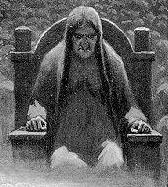


| Names: |
Proto-Germanic: *Haljô (hole/shelter?) Western Germanic: Hel, Hela, Hella, Hol, Holda, Holle, Hölle, Hulda Northern Germanic: Hel |
| Goddess of: |
The Afterlife, the Dead |
| Appearance: |
Hel was originally depicted as a wise old woman but in later sources she became an ugly woman with rotting flesh on her bones who looked like a corpse. |
